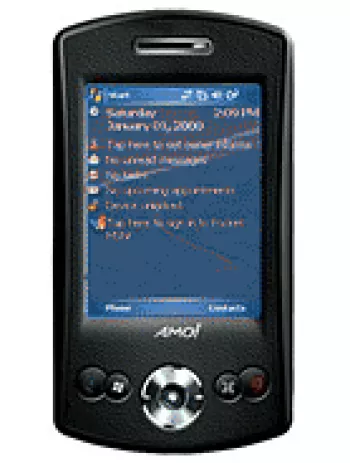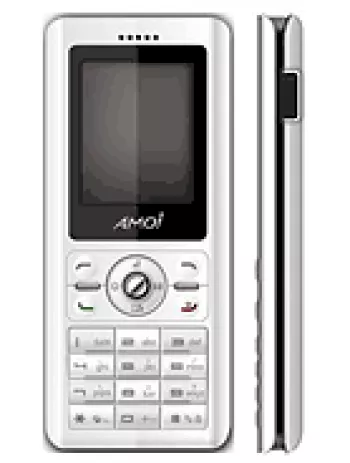
Overview of Amoi CA8
The Amoi CA8, launched in 2003, is a feature phone that was part of the early 2000s wave of mobile connectivity. As a discontinued model, it offers insight into the mobile technology landscape of its time. This article provides a comprehensive overview of the device's specifications, features, and technological capabilities.
Design and Build
The Amoi CA8 was built with a compact design, measuring 85.8 x 49 x 24.6 mm and weighing only 80 grams. This made it a portable device that could easily fit in pockets and small bags. The Mini-SIM functionality was standard for the era, allowing users to switch between networks with ease.
Display
The phone featured a CSTN display with 65K colors, which was typical for feature phones at the time. The screen resolution was 128 x 160 pixels, sufficient for basic browsing and display of messages. Although the screen size is unspecified, these characteristics suggest a small, yet practical display, suitable for the device’s capabilities.
Network Technology
The Amoi CA8 operated on GSM technology with 2G network bands covering GSM 900, 1800, and 1900. The phone supported GPRS for data transfer, but did not include EDGE, restricting it to basic data services and texting.
Battery Life
Equipped with a removable Li-Ion 860 mAh battery, the Amoi CA8 promised standby time of up to 100 hours and talk time of up to 3 hours. These specifications ensured that users could maintain connectivity throughout the day without frequent recharging.
Memory and Storage
The device did not support additional storage cards, which was a limitation for users wanting to store more data. However, it offered a phonebook capacity of up to 500 contacts and could log 10 dialed, 10 received, and 10 missed calls, which was adequate for basic communication needs.
Sound and Alerts
The CA8 lacked a loudspeaker and 3.5mm jack, focusing instead on traditional alert types like vibration and polyphonic ringtones. These features reflect the intended use of feature phones primarily for voice and text communication rather than multimedia consumption.
Communication Features
In terms of communications, the phone focused on simplicity, offering SMS and MMS messaging, but no Bluetooth or WLAN capabilities. The lack of modern connectivity options limited its use for data-heavy tasks but aligned with the typical usage patterns during its release period. WAP browsing was available, allowing for basic internet access.
Additional Features
Enhancing its entertainment options, the Amoi CA8 included 5 preset games with the option to download additional Java-based games. Java support also enabled the installation of basic applications and customization of the device to some extent.
Market Position and Historical Context
Upon its release, the Amoi CA8 targeted users looking for reliable mobile communication with extended battery life. In the context of early 2000s technology, its features were competitive, emphasizing straightforward telephony over advanced data functionalities. This positioned it as a suitable option for users in need of a robust mobile solution without the complexities of emerging smartphone features.
Conclusion
The Amoi CA8 serves as a representation of early 2000s technology innovations, offering basic yet essential features for mobile communication. It illustrates the focus of that era on durability, practicality, and user-friendly interfaces, underscoring the significant advances in mobile technology over the subsequent decades.
Key Features of Amoi CA8
- Compact Size: The phone has a compact dimension of 85.8 x 49 x 24.6 mm, making it easy to carry.
- Lightweight Design: Weighing only 80 g, it is extremely lightweight and portable.
- Color Display: Features a CSTN display with 65K colors and a resolution of 128 x 160 pixels.
- Phonebook Capacity: Ability to store up to 500 contacts in the phonebook.
- Call Records: Keeps track of 10 dialed, 10 received, and 10 missed calls.
- Removable Battery: Equipped with a removable Li-Ion 860 mAh battery.
- Stand-by and Talk Time: Provides up to 100 hours of stand-by and up to 3 hours of talk time.
- Messaging: Supports SMS and MMS messaging capabilities.
- Java Support: Includes Java compatibility for downloadable applications and games.
- Games: Comes with 5 pre-installed games and allows for additional Java downloadable games.
- Polyphonic Ringtones: Offers polyphonic ringtones with up to 40 chords.
Disadvantages of Amoi CA8
- No support for 3G or newer technologies; only GSM and 2G bands supported.
- Discontinued model; announced back in 2003.
- No EDGE support for internet connectivity; limited to GPRS.
- No expandable memory; lacks a card slot.
- Absence of a camera feature.
- Lacks both loudspeaker and 3.5mm audio jack.
- No wireless communication options such as Bluetooth or WLAN.
- No built-in GPS or radio functionality.
- Limited standby and talk time offered by the battery.
View Also
More Phones
All Rights Reserved +13675 Phones © Mobilawy 2025

























